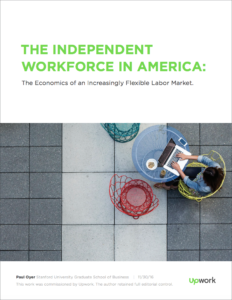The Independent Workforce in America: The Economics of an Increasingly Flexible Labor Market 
Paul Oyer for Upwork
First published December 2016
The composition of the US workforce is changing as demographic shifts impact labor supply and demand, interstate commerce and international trade grow, and technology makes it easier for people to work independently. The independent workforce (“IW”) has grown to become a sizable share of the American labor pool and is widely expected to grow even larger in coming years. This growth has created (and will continue to create) large benefits for the US economy, both for the IW itself and the buyers of their services.
As technology has enabled the growth in the IW, independent work has grown at a faster rate, in terms of attention from the media and those interested in influencing policy, than its growth in the actual economy. As this part of the economy grows and changes rapidly, analyzing the IW requires looking at somewhat of a moving target. In order for policymakers and the business world to make the best decisions about how to shape and make use of the IW, it is important to understand the variety in the IW labor market as it currently stands, and how this part of the economy is likely to develop.
This study, which was commissioned by Upwork, the world’s largest freelancing marketplace, places the IW in context by examining the economic drivers, impacts, and facts around the growth of work performed by self-employed professionals and other freelance businesses. To more fully understand the IW and provide informed judgments about the wisdom of policy reforms that may affect freelancers and their economic opportunities, this study analyzed two distinct data sources and reviewed the related literature. The primary data sources are the 2014 and 2015 Freelancing in America (“FIA”) survey of American workers co-sponsored by Freelancers Union and Upwork, and the 2015 transactions between buyers and sellers using Upwork’s website.
Download Resource